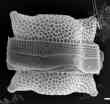|
Plants that live in glass houses
On a recent visit home, our daughter, Penny, enthusiastically regaled us with an account of one of her favorite lectures from her four-year botany course. Even the lecturer apparently grew uncharacteristically animated when waxing eloquent on the topic - diatoms, single-celled algae that live in houses made of a substance akin to glass. Something about diatoms seems to stir even the most passive of souls who give themselves to their study. While working as a laboratory technician in the botany department at Melbourne University many moons back, I became acquainted with Prof. H. A. Von Stosch (if I ever heard his first name I have forgotten it), world-renowned diatom expert from Germany who was visiting on a working furlough. He rarely emerged from his modest chamber abutting the laboratory where I propagated fungi, but when he did, tutting and smiling and looking for his German colleague, Sophie Ducker, we knew he had "discovered" something important. I once pulled the short straw and had to run the slide projector for a lecture he gave to an audience of academics. Though clearly not an effusive personality, the professor would transform into a Carmen Miranda-like figure when talking about his babies.
About 5,000 species of diatoms have been described, but the actual number may run into hundreds of thousands. The greatest variety is found in the plankton of oceans where they are responsible for almost 25% of earth's oxygen production. The tiny blob of living, photosynthesizing protoplasm lives inside what can best be likened to a glass hat box or shoe box in which the lid (epitheca) fits over the box (hypotheca) with a split between them, only in this case the lid usually extends almost all the way down the side of the box. As the living matter inside grows, the two walls are pushed apart, but each one adds strip after strip of silica to its rim so that they don't pull apart. Each one continually Diatom glass houses come in a staggering array of shapes, many of them of exquisitely beautiful and intricately ornamented with ribs and spines "radiating in spectacular geometry across the minute cell surfaces" (Hallegraeff).
The Creator has devised remarkable solutions to endless problems posed by basic design form. Diatom protoplasm must have access to gas and nutrients, but glass is not porous. Solution: perforate the walls with thousands of tiny pores. (How did plankton ancestors survive for millions of
|
years before they evolved the ability to make pores?) But diatoms face an even bigger problem - how to reproduce and maintain high populations. How does a blob of protoplasm locked up inside a rigid hatbox make two blobs locked up in two hatboxes? Well, to begin with, the living flesh divides into two tiny blobs, similar to the way in which amoebae divide. Then, each protoplast secretes a new wall fitting snugly inside whichever of the two original walls it ended up with. Naturally, this process pushes the two pairs of walls apart until eventually they separate. But a problem arises. Since the walls cannot expand in size, one of the two new diatoms must be smaller than its parent. (The one that inherited the larger wall is the same size as the parent, but the one that inherited the smaller of the two will be the size of the smaller original wall.) So, the average size of any population must decrease steadily over time!

Solution: a separate reproductive phase. When a diatom reaches a certain minimum size, the protoplast produces free-living male and female gametes which, upon fertilization, are able to survive and grow without an enclosing glass wall. During this phase, the diatom protects itself by secreting a very complex covering that is tough yet expandable. When it reaches full size, it replaces the covering with two new glass walls - ready to start the cycle again.
Prof. Von Stosch did not seem to get excited about much, but he was as lively as a puppy who had just discovered his tail when it came to diatoms. He was rapt in one tiny aspect of God's creation. How sad that his boundless admiration for scum didn't extend to the God who created it. The sons of this world are often more enamored of the creation than the sons of light. Christians need to develop a love of God's works. After all, He Himself takes pleasure in His own works:
May the glory of the Lord endure forever; may the Lord rejoice in His works (Ps. 104:31).
God rejoices in His own works. Shouldn't we do the same?
|







